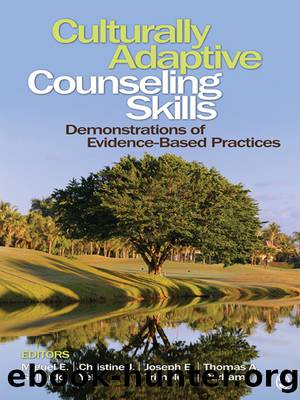Culturally Adaptive Counseling Skills by Gallardo Miguel E.;Yeh Christine Jean;Trimble Joseph E.;Parham Thomas A.;

Author:Gallardo, Miguel E.;Yeh, Christine Jean;Trimble, Joseph E.;Parham, Thomas A.;
Language: eng
Format: epub
Publisher: SAGE Publications, Incorporated
Published: 2011-01-24T00:00:00+00:00
PART IV
North American Indian and Alaska Native Communities
Moving Beyond the Surface Level
* * *
11
Working With North American Indian and Alaska Native Clients
* * *
Understanding the
Deep Culture Within
Joseph E. Trimble
Non-Native mental health counselors who work with North American Indians and Alaska Natives must understand the extraordinarily diverse demographic and individual identity characteristics of the groups that make up North Americaâs indigenous populations. These populations are no doubt more diverse than those that make up the rich tapestry of national and ethnic groups in European countries. Native North American Indians reside in all of Canadaâs provinces and in all of the U.S. states. In the United States, about 60% of them reside in urban areas, with the remainder living in rural villages and small rural communities and on reservations (U.S. Census Bureau, 2006). An unknown number follow traditional lifestyles, and countless others embrace the values and lifestyles of the common North American culture (Herring, 1990; Trimble, 1981; Trimble & Gonzalez, 2008). The extraordinary variation in lifestyle orientations and physical appearance among the Native populations presents a daunting challenge for anyone who tends to view American Indians as a homogeneous group.
Indeed, the tendency of non-Natives to view American Indians and Alaska Natives in a collective manner has been a source of considerable concern among scholars (Trimble & Dickson, 2005); that is, there is the tendency to gloss over the rich cultural heterogeneity that exists in numerous tribal and linguistic groups by referring to them with a sweeping label. It may well be the major reason so many non-Natives experience difficulty understanding the complexity of the varied lifeways and thoughtways of Native North American Indian populations.
In the past four decades, scholars and practitioners have published more than 150 articles related directly or indirectly to the provision of counseling and psychotherapeutic services to Indians; more than 40% of these articles have been published in the past five years alone (Herring, 1999; Trimble & Bagwell, 1995). A theme occurs repeatedly in the Indian and Native literature: Counselors of Indian and Native clients must be adaptive and flexible in their personal orientations and in their use of conventional counseling techniques. Additionally, one finds that numerous scholars, mental health specialists, and practitioners provide insights, observations, and recommendations for a variety of settings and situations. After poring over the publications, invariably questions arise as to what is the best and most culturally respectful way to deliver counseling services to North Americaâs indigenous populations.
Considering the range of individual differences between Indians and Natives who subscribe closely to tribal worldviews and those who marginally identify as Indian or Native, how can a counselor provide effective and culturally resonant mental health services to members of these populations? Is there a common set of procedures and strategies available that are known to be effective? What does a conventionally trained counselor need to know about facilitating positive relationships with Indian and Native clients? Many counselors have been unsuccessful with them, and not because of a lack of effort and concern. Counselors may be unsuccessful
Download
This site does not store any files on its server. We only index and link to content provided by other sites. Please contact the content providers to delete copyright contents if any and email us, we'll remove relevant links or contents immediately.
The Art of Thinking Clearly by Rolf Dobelli(10075)
The 5 Love Languages: The Secret to Love That Lasts by Gary Chapman(9428)
Mindhunter: Inside the FBI's Elite Serial Crime Unit by John E. Douglas & Mark Olshaker(8973)
Becoming Supernatural by Dr. Joe Dispenza(7972)
The Road Less Traveled by M. Scott Peck(7401)
Nudge - Improving Decisions about Health, Wealth, and Happiness by Thaler Sunstein(7398)
Mastermind: How to Think Like Sherlock Holmes by Maria Konnikova(7076)
Enlightenment Now: The Case for Reason, Science, Humanism, and Progress by Steven Pinker(7025)
Win Bigly by Scott Adams(6972)
The Way of Zen by Alan W. Watts(6393)
Factfulness: Ten Reasons We're Wrong About the World – and Why Things Are Better Than You Think by Hans Rosling(4576)
The State of Affairs by Esther Perel(4539)
Gerald's Game by Stephen King(4471)
Man's Search for Meaning by Viktor Frankl(4329)
The Confidence Code by Katty Kay(4117)
Thinking in Bets by Annie Duke(4079)
Hidden Persuasion: 33 psychological influence techniques in advertising by Marc Andrews & Matthijs van Leeuwen & Rick van Baaren(3371)
The Worm at the Core by Sheldon Solomon(3367)
The Healing Self by Deepak Chopra(3346)
